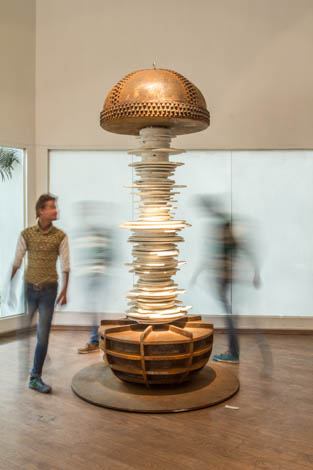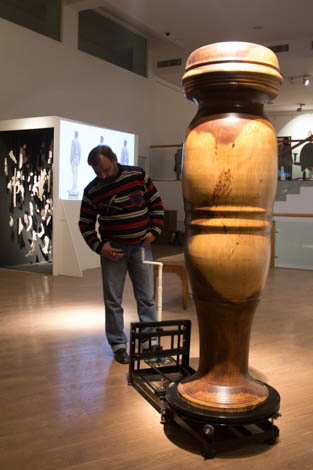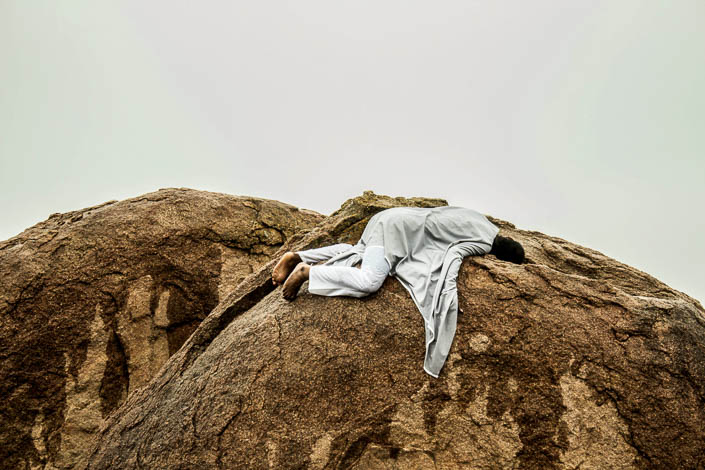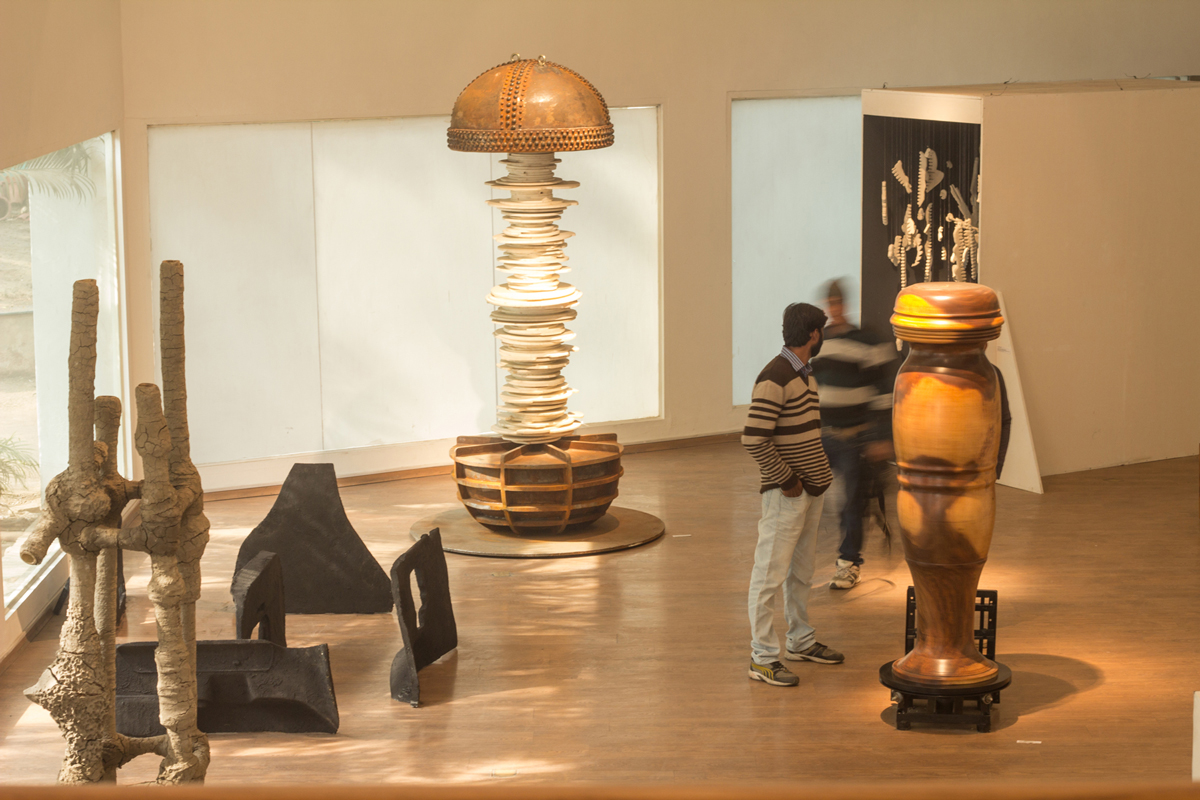‘Whirling Out’: an exhibition of sculptures | New Delhi, India
‘Whirling Out’
‘Whirling Out’, Harsha Vardhan’s debut solo show brought together a body of works incorporating diverse media such as sculpture, video, performance and installations. He believes his work is about the other, and even personal history is somehow very peripheral to him. Harsha tries to shift the focus from the individual, particularly the artist himself towards the other, plainly spinning out. The exhibition can be described as a laboratory where Harsha has experimented with various materials and philosophies.The works revolve around the idea of whirling out, both bodily and metaphysically, being inspired by the whirling Dervishes in Turkey. The work is also a refreshing tactile departure from the “don't touch” rules in today's art world.
 The show’s centerpiece is the sound sculpture ‘Column of Sound’ which shape-shifts sound into tactile form; it stands tall, as the artist brings tactility to sound through material, turning the hidden inside out.
The show’s centerpiece is the sound sculpture ‘Column of Sound’ which shape-shifts sound into tactile form; it stands tall, as the artist brings tactility to sound through material, turning the hidden inside out.
The ‘Whirling Man’ is a life sized revolving portrait of the artist himself, representing spinning as life energy. The mobile sculpture is a manifestation of the artist’s body, as if in full spinning motion, which could be rotated by the spectator.  The metaphor the work embodies comes from the principles of inertia and angular momentum which exist everywhere from atoms to the planets. It is scientifically recognized that the fundamental condition of our existence is to revolve. There is no being or object which does not revolve, since all beings are comprised of revolving electrons, protons, and neutrons in atoms. Everything revolves, and the human being lives by means of the revolution of these particles, by the revolution of the blood in his body, and by the revolution of the stages of his life, by his coming from the earth and his returning to it. All these revolutions are natural and unconscious. But the human being possesses a mind and an intelligence. Thus, the whirling Dervishes intentionally and consciously participate in the shared revolution of other beings.
The metaphor the work embodies comes from the principles of inertia and angular momentum which exist everywhere from atoms to the planets. It is scientifically recognized that the fundamental condition of our existence is to revolve. There is no being or object which does not revolve, since all beings are comprised of revolving electrons, protons, and neutrons in atoms. Everything revolves, and the human being lives by means of the revolution of these particles, by the revolution of the blood in his body, and by the revolution of the stages of his life, by his coming from the earth and his returning to it. All these revolutions are natural and unconscious. But the human being possesses a mind and an intelligence. Thus, the whirling Dervishes intentionally and consciously participate in the shared revolution of other beings.
 An early impetus of the spinning portraits stems from the work ‘Spin Face‘ a revolving portrait which ceases to spin as if staring back at us. In sculptural form it is half-human and half spin-top. A maze carved on the revolving spin-top is only visible when motionless.
An early impetus of the spinning portraits stems from the work ‘Spin Face‘ a revolving portrait which ceases to spin as if staring back at us. In sculptural form it is half-human and half spin-top. A maze carved on the revolving spin-top is only visible when motionless.
Both ‘Knots’ and ‘Boulders’ are video performances which reflect on two ideas about human relations with other beings and with the rest of nature. ‘Boulders’ symbolic represents the boulders which have taken 2,500 million years to form on this planet. These graceful boulders, in a variety of shapes and sizes, have withstood the vagaries of nature and its elements for ages.  These formations are in the danger of being reduced to rubble due to the onslaught of relentless urbanization and mindless development. In the midst of cacophony, one finds solace in the aesthetics of a boulder and might emotionally connect to its existence. As an artist I try to explore the relation between boulders and humans which drown in tears as I hug them in grief.
These formations are in the danger of being reduced to rubble due to the onslaught of relentless urbanization and mindless development. In the midst of cacophony, one finds solace in the aesthetics of a boulder and might emotionally connect to its existence. As an artist I try to explore the relation between boulders and humans which drown in tears as I hug them in grief.
‘Knots’ is a public intervention which questions the role of knots in the Indian marriage, playing a pivot role in bonding two human beings. Indian marriage starts with a knot imposing a belief that enables two humans to be together for life. During the performance knots were tied to the artist by fellow artists and participants who joined in the process of making knots, thereby critiquing the institution of marriage and its relevance in today’s age. Locals joined to tie three knots symbolic of the South Indian marriage, thereby raising questions about the rituals of marriage.

 Harsha V Durugadda (b.1989) is a New Delhi based artist. Harsha uses scale and sensation to address both social and personal issues, through his practice which often moves between sculpture and performance art. Technology becomes key to Harsha’s work, be it cutting edge digital fabrication or new media tools. In 2015 his sculpture ‘Dynamo’ was part of EAS international ‘Translations’ exhibition in Portland, Oregon, followed by group show in London with artist collective ‘Plastic Propaganda’, and by the exhibition ‘Translations-Kolkata’ in Kolkata, India, in February 2016. He has participated in group and solo shows both in India and abroad and has received a fellowship by the British Council for his social art project. He currently is doing his Masters in Arts and Aesthetics at JNU where he pursues his interest in Buddhist sculpture and has recently been invited to present at the British Museum, London .
Harsha V Durugadda (b.1989) is a New Delhi based artist. Harsha uses scale and sensation to address both social and personal issues, through his practice which often moves between sculpture and performance art. Technology becomes key to Harsha’s work, be it cutting edge digital fabrication or new media tools. In 2015 his sculpture ‘Dynamo’ was part of EAS international ‘Translations’ exhibition in Portland, Oregon, followed by group show in London with artist collective ‘Plastic Propaganda’, and by the exhibition ‘Translations-Kolkata’ in Kolkata, India, in February 2016. He has participated in group and solo shows both in India and abroad and has received a fellowship by the British Council for his social art project. He currently is doing his Masters in Arts and Aesthetics at JNU where he pursues his interest in Buddhist sculpture and has recently been invited to present at the British Museum, London .